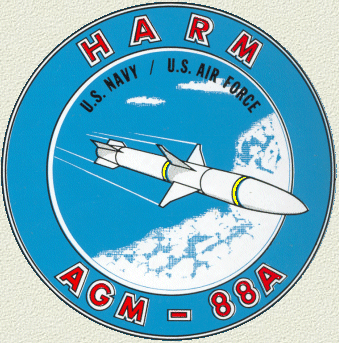|




EA-6B Prowler
EA-6B Prowler
EA-6B Squadrons
Preserved EA-6Bs
EA-6B Photo Gallery
EA-6B Video Gallery
EA-6B Patches
AGM-88 HARM
EA-18G Growler
EA-18G Squadrons
EA-18G Patches
VAQ-136
Gauntlets
Squadron History
Squadron Emblem
Squadron CO's
Squadron Cruises
Memorabilia
Patch Collection
Photo Gallery
Video Gallery
VAQ-136 Art for Sale
IRONCLAW Book
VAQ-136 Links
MidwaySailor Store
USS Midway
Military Section
Photo Galleries
My Scale Models
London Central
Who am I?



|

~ Missile History ~
In 1972 the U.S. Naval Weapons Center began research and development and also funded industry studies for an anti-radiation missile successor to the tactically limited AGM-45 Shrike and the costly (and weighty) AGM-78 Standard ARM. Among the objectives were much higher flight speed, and to combine the low cost and versatility of Shrike, the sensitivity and large launch envelope of Standard ARM, and completely new passive homing using the latest microelectronic digital techniques and interfacing with new aircraft systems. In 1974, Texas Instruments was selected as system integration contractor for the AGM-88 High Speed Anti-Radiation Missile (HARM).
The AGM-88 is a large weapon, weighing 800 pounds with a long cylindrical body, a cruciform of cropped double-delta control surfaces at the mid-point, and a cruciform of fixed low-aspect-ratio fins at the rear, indexed in line with the control surfaces. A smokeless, solid propellant, dual-thrust rocket motor propels the missile and has a range of more than 40 miles.
The HARM is an air-to-surface tactical missile designed to seek out and destroy enemy radar-equipped air defense systems. It can detect, attack and destroy a target with minimum aircrew input. The proportional guidance system that homes in on enemy radar emissions has a fixed antenna and seeker head in the missile's nose. This radar seeker covers a wide range of frequencies and may be quickly reprogrammed to handle new threats. The missile has an active laser fuse and uses a 150-pound warhead containing thousands of tungsten alloy cubes to destroy a target.
The AGM-88 offers good passive radiation homing with detection from the launch aircraft's sensor suite. The missile's high speed also gives the hostile emitter a minimum time to shut down. One of the HARMs greatest advantages over the Shrike is the use of a single broadband seeker rather than a choice of individually tailored seekers, making it possible for a single seeker to be used against the whole electronic range of land and ship based air-defense radars. Two other improvements are a continued homing capability even after the target emitter has been closed down (thanks to the incorporation of a memory in the guidance system) and software-controlled signal processing, giving the possibility of role expansion to cover additional radar emitters.
The HARM can be used in any one of three modes. The basic use is Self-protection mode when the launch aircraft's radar-warning receiver detects a hostile emitter and programs the missile before launch. In the Pre-briefed mode, the missile is fired blind towards a possible target with the seeker searching in flight and commanding a self-destruct if no target is discovered. In the Target-of-Opportunity mode the very sensitive seeker of the unfired missile locks on to certain parameters of emitter operation and also transmissions associated with other parts of a radar installation.
Test flights of the HARM began in 1976. However, redesign was necessary and required a prolonged further testing period. In March 1981, the U.S. Defense Systems Acquisition Review Council approved the AGM-88 HARM for full production as a joint U.S. Air Force
and U.S. Navy project. Delivery to operational units began in 1983.
The AGM-88 HARM saw combat for the first time against Libyan targets in the Gulf of Sidra in 1986. During
Operation DESERT STORM, U.S. aircraft fired 1,961 missiles against Iraqi targets. Over 20,000 HARMs have been ordered since production began.

~ Specifications ~
|
Primary Function: |
Air-to-surface anti-radiation missile |
|
Contractors: |
Raytheon & Texas Instruments |
|
Power Plant: |
Thiokol solid propellant, low smoke rocket motor |
|
Guidance System: |
Passive radiation seeking |
|
Warhead: |
150 lb (68 kg) high explosive blast fragmentation with proximity fuse system |
|
Unit Cost: |
$284,000 |
|
Length: |
13 ft, 8.5 in (4.17 m) |
|
Diameter: |
10 in (25.40 cm) |
|
Wingspan: |
44 in (1.13 m) |
|
Weight: |
796 lb (361.1 kg) |
|
Range: |
46+ m (74+ km) |
|
Speed: |
Mach 2.0+ |
~ Model Details ~
|
AGM-88A |
Programmed in factory |
|
AGM-88B |
Reprogrammable in the field |
|
AGM-88C |
Improved seeker, software, and warhead |
Please click a thumbnail to view the larger image.
Images will open in a new window.
REFERENCES:
Aircraft Armaments Recognition, by Christopher Chant
Combat Fleets of the World 1993, by Prezelin and Baker
Modern Airborne Missiles, by Bill Gunston
Raytheon Corporation
U.S. Navy

|